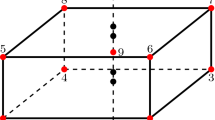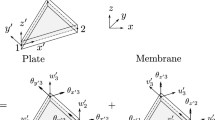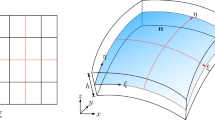Abstract
In the structural analysis of thin elastic structures using standard FEMs within the poor approximation space, the numerical results may suffer from the quality deterioration called the locking phenomenon. This situation becomes more crucial for the structures with non-vanishing curvatures, such as arch- and shell-like bodies, owing to the additional membrane constraints. In addition, the choice of unsuitable shear correction factor (SCF), in dimen-sionally-reduced first-order analysis models, may become an additional source for the quality deterioration. In this context, we here propose a locking-free robust finite element approximation for the robust structural analysis of shell-like structures, by improving the degenerated 8-node shell element. In order to completely overcome the quality deterioration according to the thickness reduction, we combine the reduced integration (RI) and the modified shear correction factor.
Similar content being viewed by others
References
V. V. Novozhilov, Thin Shell Theory, Wolters-Noordhoff Publishing, Groningen (1970).
Ph. Destuynder, A classification of thin shell theories, Acta Applicandae Mathematicae, 4 (1985) 15–63.
R. J. Melosh, A stiffness matrix for the analysis of thin plates in bending, Journal of the Aerospace Science, 28 (1) (1961) 34–42.
R. H. Gallagher, Stress analysis of heated complex shapes, ARS Journal, 32 (5) 700–707.
B. M. Irons, Engineering applications of numerical integration in stiffness methods, AIAA Journal, 4 (11) (1966) 2035–2037.
S. Ahmad, B. M. Irons and O. C. Zienkiewicz, Analysis of thick and thin shell structures by curved finite elements, International Journal for Numerical Methods in Engineering, 2 (1970) 419–451.
R. H. MacNeal, Perspective on finite elements for shell analysis, Finite Elements in Analysis and Design, 30 (1998) 175–186.
J. Pitkäranta, The problem of membrane locking in finite element analysis of cylindrical shells, Numerical Mathematics, 61 (1992) 523–.
O. C. Zienkiewicz, J. Too and R. L. Taylor, Reduced integration technique in general analysis of plates and shells, International Journal for Numerical Methods in Engineering, 3 (1971) 275–290.
O. C. Zienkiewicz and R. L. Taylor, The Finite Element Method, McGraw-Hill, New York (1991).
F. G. Flores, A simple reduced integration hexahedral solidshell element for large strains, Computer Methods in Applied Mechanics and Engineering, 303 (2016) 260–287.
C. K. Choi and S. H. Kim, Coupled use of reduced integration and nonconforming modes in quadratic Mindlin element, International Journal for Numerical Methods in Engineering, 28 (1989) 1909–1928.
K. J. Bathe, Finite Element Procedures, Prentice-Hall, Inc. (1996).
B. A. Izzuddinm and Y. Liang, A hierarchic optimization approach towards locking-free shell finite elements, Computers & Structures, 232 (2020) 105839.
H. Jun, K. Yoon, P. S. Lee and K. J. Bathe, The MITC3+ shell element enriched in membrane displacements by interpolation covers, Computer Methods in Applied Mechanics and Engineering, 337 (1) (2018) 458–480.
E. Oñate and F. Zárate, Rotation-free triangular plate and shell element, International Journal for Numerical Methods in Engineering, 47 (2000) 557–603.
J. R. Cho, H. W. Lee and W. S. Yoo, Natural element approximation of Reissner-Mindlin plate for locking free numerical analysis of plate-like thin elastic structures, Computer Methods in Applied Mechanics and Engineering, 256 (2013) 17–28.
Q. Hu, S. Natarajan, A. Zilian, P. Hu and S. P. A. Bordas, Isogeometric analysis of thin Reissner-Mindlin shell: locking phenomena and B-bar method, Computational Mechanics, 65 (2020) 1323–1342.
R. A. Adams, Sobolev Spaces, Academic Press, New York (1978).
R. D. Cook, Concepts and Applications of Finite Element Analysis, John Wiley & Sons, Inc. (1989).
J. R. Cho and J. T. Oden, A priori error estimation of hp-finite element approximations for hierarchical models of plate- and shell-like structures, Computer Methods in Applied Mechanics and Engineering, 132 (1996) 135–177.
J. R. Cho and J. T. Oden, Locking and boundary layer in hierarchical models for thin elastic structures, Computer Methods in Applied Mechanics and Engineering, 149 (1997) 33–48.
MacNeal-Schendler Corporation, MSC/Nastran Linear Static Analysis User’s Guide..
ANSYS, Theory Reference, SAS IP, Inc.
Acknowledgements
This work was supported by 2020 Hongik University Research Fund. This research was supported by Basic Science Research Program through the National Research Foundation of Korea (NRF) funded by the Ministry of Education (Grant No. NRF-2020R1A2C1100924).
Author information
Authors and Affiliations
Corresponding author
Additional information
Jin-Rae Cho received his B.S. degree in Aeronautical Engineering from Seoul National University in 1983. He then received his M.S. and Ph.D. degrees from The University of Texas at Austin in 1993 and 1995, respectively. He is currently a Professor at the Department of Naval Architecture and Ocean Engineering in Hongik University. His major research field is the computational mechanics in solid/structural mechanics, ocean engineering and materials science.
Rights and permissions
About this article
Cite this article
Lee, HW., Cho, JR. & Kim, DY. Locking-free robust finite element approximation of thin shell-like structures. J Mech Sci Technol 34, 3701–3708 (2020). https://doi.org/10.1007/s12206-020-0822-z
Received:
Revised:
Accepted:
Published:
Issue Date:
DOI: https://doi.org/10.1007/s12206-020-0822-z




